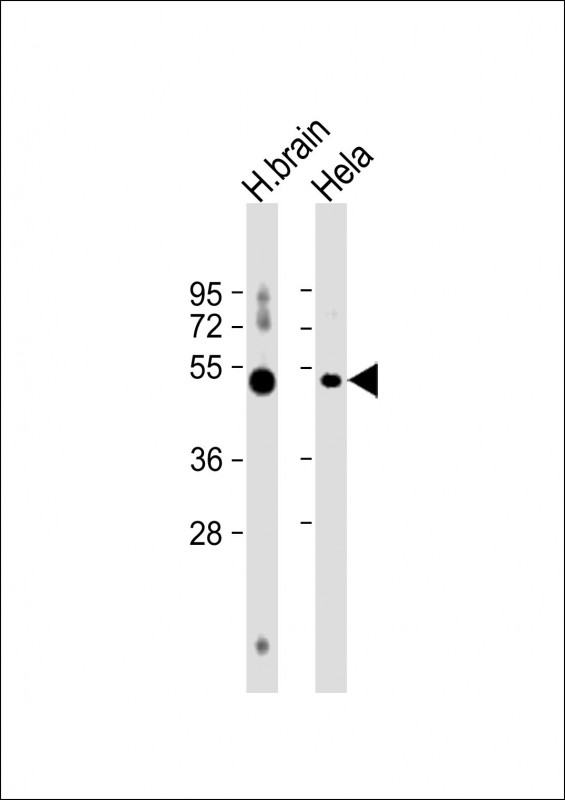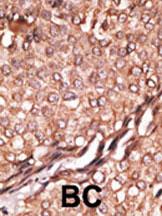BAIAP2 Antibody (C-term)
Purified Rabbit Polyclonal Antibody (Pab)
- 产品详情
- 实验流程
- 背景知识
Application
| WB, IHC-P, E |
|---|---|
| Primary Accession | Q9UQB8 |
| Other Accession | NP_006331 |
| Reactivity | Human, Mouse |
| Host | Rabbit |
| Clonality | Polyclonal |
| Isotype | Rabbit IgG |
| Calculated MW | 60868 Da |
| Antigen Region | 492-518 aa |
| Gene ID | 10458 |
|---|---|
| Other Names | Brain-specific angiogenesis inhibitor 1-associated protein 2, BAI-associated protein 2, BAI1-associated protein 2, Protein BAP2, Fas ligand-associated factor 3, FLAF3, Insulin receptor substrate p53/p58, IRS-58, IRSp53/58, Insulin receptor substrate protein of 53 kDa, IRSp53, Insulin receptor substrate p53, BAIAP2 |
| Target/Specificity | This BAIAP2 antibody is generated from rabbits immunized with a KLH conjugated synthetic peptide between 492-518 amino acids from the C-terminal region of human BAIAP2. |
| Dilution | WB~~1:1000 IHC-P~~1:100~500 E~~Use at an assay dependent concentration. |
| Format | Purified polyclonal antibody supplied in PBS with 0.09% (W/V) sodium azide. This antibody is prepared by Saturated Ammonium Sulfate (SAS) precipitation followed by dialysis against PBS. |
| Storage | Maintain refrigerated at 2-8°C for up to 2 weeks. For long term storage store at -20°C in small aliquots to prevent freeze-thaw cycles. |
| Precautions | BAIAP2 Antibody (C-term) is for research use only and not for use in diagnostic or therapeutic procedures. |
| Name | BAIAP2 |
|---|---|
| Function | Adapter protein that links membrane-bound small G-proteins to cytoplasmic effector proteins. Necessary for CDC42-mediated reorganization of the actin cytoskeleton and for RAC1-mediated membrane ruffling. Involved in the regulation of the actin cytoskeleton by WASF family members and the Arp2/3 complex. Plays a role in neurite growth. Acts syngeristically with ENAH to promote filipodia formation. Plays a role in the reorganization of the actin cytoskeleton in response to bacterial infection. Participates in actin bundling when associated with EPS8, promoting filopodial protrusions. |
| Cellular Location | Cytoplasm. Membrane; Peripheral membrane protein. Cell projection, filopodium. Cell projection, ruffle. Cytoplasm, cytoskeleton. Note=Detected throughout the cytoplasm in the absence of specific binding partners. Detected in filopodia and close to membrane ruffles. Recruited to actin pedestals that are formed upon infection by bacteria at bacterial attachment sites |
| Tissue Location | Isoform 1 and isoform 4 are expressed almost exclusively in brain. Isoform 4 is barely detectable in placenta, prostate and testis. A short isoform is ubiquitous, with the highest expression in liver, prostate, testis and placenta |
For Research Use Only. Not For Use In Diagnostic Procedures.
Provided below are standard protocols that you may find useful for product applications.
BACKGROUND
BAIAP2, a target of p53, has been identified as a brain-specific angiogenesis inhibitor (BAI1)-binding protein. This interaction at the cytoplasmic membrane is crucial to the function of this protein, which may be involved in neuronal growth-cone guidance. This protein functions as an insulin receptor tyrosine kinase substrate and suggests a role for insulin in the central nervous system. This protein has also been identified as interacting with the dentatorubral-pallidoluysian atrophy gene, which is associated with an autosomal dominant neurodegenerative disease. It also associates with a downstream effector of Rho small G proteins, which is associated with the formation of stress fibers and cytokinesis.
REFERENCES
Fujiwara, T., et al., Biochem. Biophys. Res. Commun. 271(3):626-629 (2000).
Abbott, M.A., et al., J. Neurosci. 19(17):7300-7308 (1999).
Okamura-Oho, Y., et al., Hum. Mol. Genet. 8(6):947-957 (1999).
Oda, K., et al., Cytogenet. Cell Genet. 84 (1-2), 75-82 (1999).
终于等到您。ABCEPTA(百远生物)抗体产品。
点击下方“我要评价 ”按钮提交您的反馈信息,您的反馈和评价是我们最宝贵的财富之一,
我们将在1-3个工作日内处理您的反馈信息。
如有疑问,联系:0512-88856768 tech-china@abcepta.com.























 癌症的基本特征包括细胞增殖、血管生成、迁移、凋亡逃避机制和细胞永生等。找到癌症发生过程中这些通路的关键标记物和对应的抗体用于检测至关重要。
癌症的基本特征包括细胞增殖、血管生成、迁移、凋亡逃避机制和细胞永生等。找到癌症发生过程中这些通路的关键标记物和对应的抗体用于检测至关重要。 为您推荐一个泛素化位点预测神器——泛素化分析工具,可以为您的蛋白的泛素化位点作出预测和评分。
为您推荐一个泛素化位点预测神器——泛素化分析工具,可以为您的蛋白的泛素化位点作出预测和评分。 细胞自噬受体图形绘图工具为你的蛋白的细胞受体结合位点作出预测和评分,识别结合到自噬通路中的蛋白是非常重要的,便于让我们理解自噬在正常生理、病理过程中的作用,如发育、细胞分化、神经退化性疾病、压力条件下、感染和癌症。
细胞自噬受体图形绘图工具为你的蛋白的细胞受体结合位点作出预测和评分,识别结合到自噬通路中的蛋白是非常重要的,便于让我们理解自噬在正常生理、病理过程中的作用,如发育、细胞分化、神经退化性疾病、压力条件下、感染和癌症。








